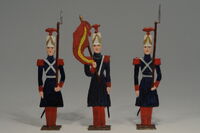
Tin soldiers at the Museu Frederic Marès in Spain.
"The Toys of Peace" is a humorous short story by the British author Hector Hugh Munro who wrote under the pseudonym of Saki. The story was first collected in the 1919 anthology of the same title.
Set in 1914, the story satirizes the campaign by the National Peace Council, a coordinating committee of anti-war organizations, against violent toys. The plot is set in motion when Eleanor asks her brother to buy "peace toys" instead of toy soldiers for her young sons. Presented with lead figures of notable civilians and other non-violent toys, the boys are at first unsure what to do. Children being resourceful, however, they soon find a way to combine the new toys with their history homework for entertainment.
A fifteen-minute radio play based on "The Toys of Peace" was produced as an episode of the five-part mini-series of Saki dramatizations Claw Marks on the Curtain.[1] The play first aired on BBC Radio 4 on May 5, 2005.
Plot[]
Eleanor Bope shows her brother Harvey a newspaper cutting about the National Peace Council. The Council will be exhibiting "peace toys" at the Children's Welfare Exhibition as alternatives to toys that promote violence. To steer boys away from their primitive instincts – since they "naturally love fighting and all the panoply of war" – the Council recommends giving them toys of civilian figures with industrial tools instead of soldiers with guns. Eleanor asks Harvey to buy her sons Eric and Bertie, aged ten and nine, some peace toys for Easter.
On Easter Saturday, Eric and Bertie watch in eager anticipation as their uncle unpacks a large box. The first item out is a featureless square building. Bertie thinks it is a fort while Eric believes it is a fortified Albanian palace. Harvey tells them it is a municipal dust bin for garbage collection. He then takes out a lead figure of John Stuart Mill, the political economist. Other buildings and civilian figures follow, including a model of the Young Women's Christian Association Manchester branch building and a figure of the Sunday school founder Robert Raikes. There are also various tools and equipment such as a wheelbarrow, a sewer ventilator, and a ballot box.
Eric asks how they are supposed to play with the civilian figures. Harvey suggests staging a contest for a seat in Parliament. The boys are excited to imagine bloody drunken fights, and Harvey quickly explains the election process. The boys lose interest and decide to work on their history homework instead. They are studying Louis XIV of France, and Eric already knows all the major battles fought during his reign. Harvey wonders whether history can be taught in elementary schools without mentioning battles, murderous intrigues, and other forms of violence.
Harvey returns later to check on the boys and finds them playing. Using the new toys, they have improvised a French invasion of Manchester. Robert Raikes is now Louis XIV, and other civilian figures are being used to represent the soldiers and the casualties. The municipal dust bin has been converted into a fort. The soldiers attack the Young Women's Christian Association and abduct the girls. J.S. Mill, in the part of Marshal Saxe, is stabbed by one of the girls. Bertie splashes red ink to illustrate the bloody death. He then proceeds to pour red ink all over the YWCA building as the soldiers massacre a hundred girls in revenge.
Harvey goes to his sister and declares the experiment a failure.
See also[]
Footnotes[]
- ↑ Other episodes of the 2005 BBC radio mini-series Claw Marks on the Curtain, all dramatized by Roger Davenport, are based on "The Lumber Room", "The Schartz-Metterklume Method", ""Fur", and "The Open Window".
